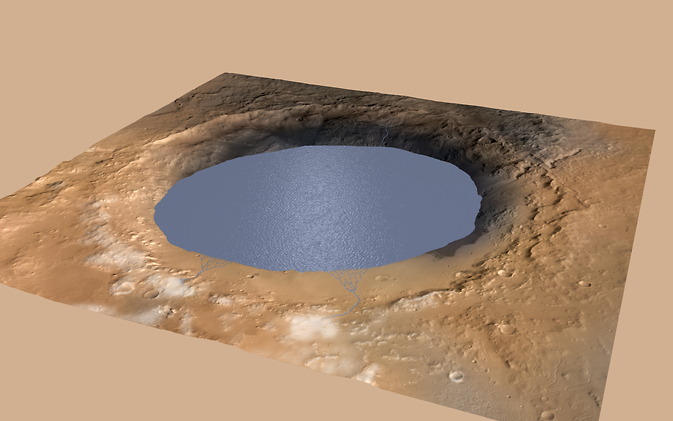NASA scientists have said that Mars may have had vast lakes billions of years ago. NASA’s Curiosity rover discovered geological evidence that suggests that a lake once filled a 96-mile (154-km) wide crater on the Red Planet.
The new findings strengthen evidence that Mars was once suitable for microbial life.
It has been two years since the rover’s sky-crane landing inside Gale Crater in August 2012 and it has traveled around 5 miles (8 kms) since landing on the planet.
Scientists analyzed rocks at the base of Mt. Sharp – a 3-mile-high mound at the center of the crater. These rocks appear to contain water-deposited sediments inclined toward the middle of the crater, they are interspersed with erosion that wind created during repeated filling and emptying of the lake.
According to NASA:
“Curiosity currently is investigating the lowest sedimentary layers of Mount Sharp, a section of rock 500 feet (150 meters) high dubbed the Murray formation. Rivers carried sand and silt to the lake, depositing the sediments at the mouth of the river to form deltas similar to those found at river mouths on Earth. This cycle occurred over and over again.”
This would mean that Mt. Sharp did not exist around 3.5 billion years ago when the crater was filled with water, according to Curiosity researchers.

This evenly layered rock photographed by the Mast Camera on NASA’s Curiosity Mars Rover on Aug. 7, 2014, shows a pattern typical of a lake-floor sedimentary deposit not far from where flowing water entered a lake. Image Credit: NASA/JPL-Caltech/MSSS
Lead scientist John Grotzinger, with the California Institute of Technology in Pasadena, said:
“Finding the inclined strata was … a complete surprise,”
“Sedimentary geology … is the cutting edge for trying to understand the Earth. When oil companies collect seismic surveys across places, they are looking for inclined strata because … then you get geometry that tells you where the rocks are that you’re looking for,” he added.
Ashwin Vasavada, Curiosity deputy project scientist at NASA’s Jet Propulsion Laboratory, said:
“If our hypothesis for Mount Sharp holds up, it challenges the notion that warm and wet conditions were transient, local, or only underground on Mars,”
“A more radical explanation is that Mars’ ancient, thicker atmosphere raised temperatures above freezing globally, but so far we don’t know how the atmosphere did that.”
Grotzinger added:
“The great thing about a lake that occurs repeatedly, over and over, is that each time it comes back it is another experiment to tell you how the environment works,”
“As Curiosity climbs higher on Mount Sharp, we will have a series of experiments to show patterns in how the atmosphere and the water and the sediments interact. We may see how the chemistry changed in the lakes over time. This is a hypothesis supported by what we have observed so far, providing a framework for testing in the coming year.”

This illustration depicts a lake of water partially filling Mars’ Gale Crater, receiving runoff from snow melting on the crater’s northern rim. Image Credit: NASA/JPL-Caltech/ESA/DLR/FU Berlin/MSSS
“The size of the lake in Gale Crater and the length of time and series that water was showing up implies that there may have been sufficient time for life to get going and thrive,” said NASA’s Mars Exploration Program scientist Michael Meyer.
See how a Martian mountain inside of a crater came to be:
